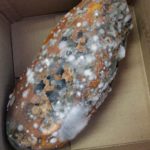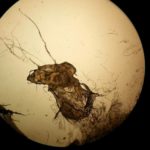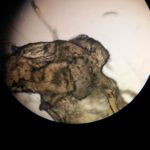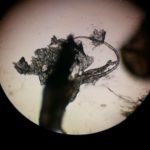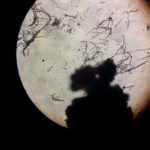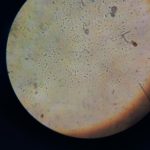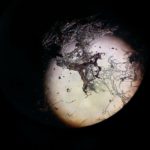Fungi Around Us
Fungi Around Us
Categoría: Medio Superior (Preparatoria)
Área de participación: Biología
Resumen
En este proyecto se estudiaron a los diferentes tipos de hongos microscópicos, que en general se producen en la comida, el propósito de ésta investigación fue el poder reconocer las diferencias y similitudes de diversos hongos microscópicos (moho) que crecen en diferentes tipos de alimento. Se utilizaron tres productos alimenticios en la primera etapa, como fueron: la papaya, pan integral y la tortilla. Uno de los factores principales que se consideró en el proyecto, es el tiempo; ya que un hongo se tarda aproximadamente una semana en aparecerse a temperatura ambiente para su observación No obstante también otro propósito del proyecto fue que a la par que encontramos los hongos, se analizara que tipo de enfermedades pueda causar al cuerpo en caso de estar en contacto con el hongo por mucho tiempo. En la primera etapa se descubrieron varios tipos de hongos en nuestros productos que se mencionaron anteriormente, ahora la segunda parte consistirá en analizar otros tipos de alimentos que también se consumen a diario. Se observará por medio de los microscopios (óptico y estereoscópico) sus estructuras y su color, para poder determinar su clasificación, a medida que pase el tiempo se determinará su origen y con base a lo obtenido podremos analizar que enfermedad pueda causar. Este proyecto también tuvo como finalidad dar a conocer lo que puede pasar a la gente si se mantiene mucho tiempo en contacto con el alimento putrefacto.
Pregunta de Investigación
¿Sera posible identificar en diferentes tipos de hongos en los alimentos, las consecuencias que sufre el ser humano al estar en contacto con ellas?Planteamiento del Problema
Los diferentes alimentos que consumimos se descomponen si no los ocupamos, en algunos de ellos crecen hongos microscópicos de diferentes tipos, ¿Serán dañinos para nuestra salud?
Antecedentes
Existen diferentes tipos de moho, visualmente podemos distinguir el verde, gris, marrón, negro, rojo y blanco; éstos liberan ligeras y diminutas esporas que pueden llegar a ser muy toxicas. El moho es un sistema de descomposición, que puede llegar reproducirse más rápido en condiciones cálidas y húmedas.
Objetivo
Reconocer las diferencias y semejanzas en los hongos microscópicos (mohos) que crecen en los distintos tipos de alimentos.
Justificación
La mayoría de los hongos microscópicos asociados a los alimentos son inofensivos, pero algunos producen toxinas que si se ingieren pueden producir enfermedades serias. En algunos casos se puede raspar o sacar a los hongos de la comida, sin embargo, aunque el micelio de la superficie haya desaparecido puede haber quedado algunos en el interior, o pueden haber liberado toxinas en la comida.
Hipótesis
Los hongos microscópicos que crecen en la comida no causan daño severo a la salud del ser humano.
Método (materiales y procedimiento)
Esta investigación es Cualitativa, ya que se observó y estudio los diferentes tipos de hongos microscópicos en diferentes alimentos, así como su relación y diferencias, ocupando ciertos instrumentos de laboratorio, la investigación es un tema elemental para este proyecto, Para iniciar se decidió elegir entre tres diferentes alimentos que la gente normalmente come todos los días, en este caso se eligió dos papayas, dos panes integrales y una tortilla. Ya elegido los alimentos se posicionaron en diferentes lugares bajo diferentes condiciones, las papayas y el pan se colocaron en dos diferentes condiciones como en la generación espontánea unas tapadas y otras al aire libre. A continuación se dejaron en su acordado lugar y se esperó a que los hongos se fueran introduciendo en la comida hasta reproducirse. A los 9 días de dejar la comida, se observó que cada alimento tenía ciertos hongos específicos de colores. Se llevó al laboratorio para poder observar con más detalle su estructura microscópica. Y después de haber observado los hongos, se investigó que tipo de hongo microscópico se había originado y con base al tipo de hongo se determinó que tipo de afectación se podría dar en el organismo.
Resultados
Se identificaron diferentes tipos de hongo en cada uno de los alimentos. En el caso de la papaya se observó tres variedades. El primero fue el penicillium en el cual se identifica como un moho de color blanco que cubría como una capa protectora a la papaya, el segundo hongo fue el verde llamado aspergillus.
En el caso del pan se observó por medio de los microscopios la formación de 2 tipos de hongos, el primero llamado rhyzopus stolonifer
En la tortilla se observó la formación de dos tipos de hongos, el primero llamado neurosfola sitofila y este tipo de hongo tiene como características un color rojo, rosa o morado tiene una reproducción asexual y ayuda para análisis genéticos este hongo no es dañino ni comestible.
Se pudo comprobar que ciertos tipos de hongos alimenticios dañan al cuerpo humano brutalmente y otros en cambio son inofensivos pero no es factible tenerlos cerca.
Discusión
Los resultados obtenidos, así como la identificación de los organismos se contrastaron con bibliografía especializada. Algunas son conocidas como alérgenos en los humanos y dentro de la casa causan rinitis y alergias. Los hongos también contaminan los alimentos y allí producen toxinas (micotoxinas) que producen efectos adversos en los organismos vivos.
Las diferentes microtoxinas conocidas, pueden producir su acción en forma aguda, sub-aguda o crónica. Algunas son cancerígenas, otras producen mutaciones y otras son teratogénicas (capaces de producir deformidades en el embrión).
Conclusiones
Se recomienda tirar la comida descompuesta en una bolsa cerrada individual para que no se contamine el lugar donde se coloque la comida y para que el hongo no pueda reproducirse con fluidez a los demás productos alimenticios.
No se deben tocar los hongos microscópicos ( moho) ya que las esporas se quedan en la piel y al tocar cualquier otra superficie se contaminaría.
Bibliografía
- Mueller GM et al. 2004. Biodiversity of Fungi. Elsevier, Amsterdam, apéndice.
- Kendrick B. 2000. The Fifth Kingdom. 3a ed. Focus Publishing, Newburyport, cap 2, 3.
- Barnett H, Hunter B. 1998. Ilustrated genera of imperfect fungi. 4a ed. APS Press. St. Paul Minnesota.
- Pitt JI, Hocking AD. 1997. Fungi and Food Spoilage. 2a ed. Blackie Academic & Professional, London, cap 2, apéndice.
Fungi Around Us
Fungi Around Us
Summary
In this project we studied the different types of fungi, which generally occur in the food. The purpose of this research was to recognize the differences and similarities of various fungi (mold) that grow in different types of food. Three food products were used in the first stage: papaya, bread and tortilla. One of the main factors to be considered in the project, is time; as a fungus takes about a week to show up at normal temperature for observation. Beside this information, at the same time we were identifying fungi, we analyzed which type of diseases can be produced in the human body after being in contact with fungus for a long time. In the first stage, various types of fungi in our products listed above were discovered. The second part is to analyze other types of foods that are also consumed daily. It will be seen through microscopes (optical and stereoscopic) their structures and color, to determine their classification, as time passes and their origin shall be determined based on the information obtained, so we can analyze which disease may cause. This project also aims to raise awareness of what can happen to people if spends a lot of time in contact with the putrid food.
Research Question
Will it be possible to identify different types of fungi in food and the consequences suffered by humans by being in contact with them?Problem approach
Different types of food are decomposed if they are not used and in some cases, different type of fungi is grown. Will it be harmful to our health?
Background
There are many types of green, black, white, gray, brown, red mold which release light and tiny spores that can be very toxic. Mold is a decomposition system that can be reproduced in a faster way in warm and humid conditions
Objective
Recognize the differences and similarities in fungi (molds) growing on different types of food.
Justification
Most fungi are harmless, but some of them produce toxins that if they are ingested can cause serious illnesses. In some cases you can scrape or take fungi out of the food, however, although the mycelium of the surface has disappeared, there may be some inside, or may have released toxins in food.
Hypothesis
The fungi that grow in food do not cause severe damages to human health
Method (materials and procedure)
This research is qualitative as it was observed and studied the different types of fungi in food, as their relationship and differences, using certain laboratory instruments. Research is a fundamental part of this project. To start with we decided to choose between three different types of food that people normally eat every day. In this case, two papayas, two slieces of bread and an omelet were chosen. Having already chosen and positioned food in different places under different conditions, papayas and the slieces of bread were placed in two different conditions in spontaneous generation, one of them covered and the other uncovered. Then, they were left in that place and waited for fungi to introduce into the food to reproduce. After 9 days of leaving the food, it was observed that each food had certain fungi food colors. They were taken to the laboratory to observe them in more detail its microscopic structure. And after observing fungi, we investigated what kind of fungus was originated and based on the type of fungus, it was determined what kind of affection could be given in the body.
Method Gallery
Results
Different types of fungus were identified in each food. In the case of the papaya, three different types of fungi were observed. The first was the penicillium (Annex 1.1) which is identified as a white mold covering the papaya as a protective layer. The second fungus called aspergillus was green.
In the case of the bread, it was observed through the microscopes, the formation of two types of fungi. The first one called Rhyzopus stolonifer.
In the tortilla, the formation of two types of fungi was observed. The first called neurosfola sitofila which is a type of mushroom that features a red, pink or purple and has an asexual reproduction and helps in genetic analysis
It was found that certain types of food fungi harm the human body, meanwhile some others are harmless but it is not recommended to have them close.
Results Gallery
Discussion
The results obtained, as well as the identification of organisms were compared with literature.
Some are known as allergens in humans causing rhinitis and allergies.
It is important to crop and resist tests or allergic.
Conclusions
It is recommended to throw rotten food in an individual sealed bag where the food is placed and the fungus can not be reproduced with other food.
Do not touch fungi (mold) because the spores are left on the skin and by touching any other surface, it would contaminate.
Bibliography
- Mueller GM et al. 2004. Biodiversity of Fungi. Elsevier, Amsterdam, apéndice.
- Kendrick B. 2000. The Fifth Kingdom. 3a ed. Focus Publishing, Newburyport, cap 2, 3.
- Barnett H, Hunter B. 1998. Illustrated genera of imperfect fungi. 4a ed. APS Press. St. Paul Minnesota.
- Pitt JI, Hocking AD. 1997. Fungi and Food Spoilage. 2a ed. Blackie Academic & Professional, London, cap 2, apéndice.


